Setting Up Cakes, Candles & Mines
These three types of firework will form the bulk of your display and all of them are designed to be secured on the ground so they can’t fall over. Note: If your firework is packaged in wire mesh then my That Pesky Pyomesh article will advise on how to safely remove it.
Table of contents:
Setting up cakes - the basics
The advice for cakes – also known as barrages – covers all the different types and sizes available as they are all designed to be secured on the ground.
Most labels on these advise you to “attach securely to an upright post”. This can cause some confusion with complete beginners so to clarify: The actual firework must be firmly on the ground and attached to a post which is next to it and holds it upright. It should not be attached to a post off the ground, or put on top of a post and so on.
The purpose of the post is to stop the cake falling over and this is absolutely essential since an unsecured cake could easily tip sideways and fire into the audience. Getting your cakes secured will significantly help towards making your display safe and should never be left out of your setting up or taken for granted. No matter how stable a cake feels on the lawn it should never be left unsupported – cakes can bounce around from the recoil of each shot, or a misfire could tip it over.
Securing your cake is easy and the process has become known as “staking and taping” as this is exactly what you will do:
- Bang a wooden stake into the ground with a hammer.
- Put the cake next to it on the ground, the right way up (as shown by the label).
- Secure the cake to the stake.
.
It really is as easy as that! Use gaffa tape, parcel tape or similar. You can use cable ties for smaller cakes but these are hard to conform to the angular shape of most larger cakes without over-tightening so I recommend you stick to tape.


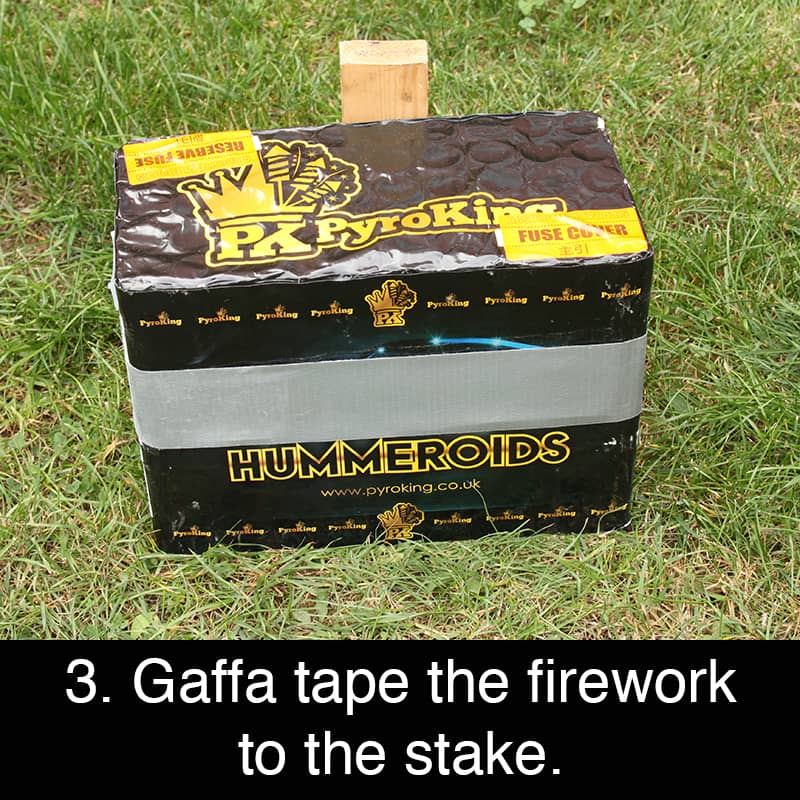

The fuse or fuses (some have a reserve fuse, see below) on cakes will be situated either on the side of the cake or on the top. Make note of its position. It must of course not be taped over, so for side-fused items either tape at the top or bottom to avoid the fuse.
If you are setting up a lot of fireworks then it helps to have a common method for situating or locating fuses. For example, always having the fuse at the front, or mark its position with a label. Ensure all the firers are familiar with the locations of the fuses.
If you intend to fire two cakes at the same time there is no reason why they cannot be attached to the same stake, but locate the fuses close to each other if you are hand lighting.
I don’t recommend putting cakes in a bucket or barrel of loose sand if the label tells you to attach it to a stake. The cake can easily move around in loose sand and tip over.
If you want extra stability – particularly important if the ground is uneven or damp – you can situate the cake on a small wooden board as shown as the optional step in the images above.
If the cake comes in its own box and providing it is quite snug in the box (and not moving around) and the fuses are located on the top it is perfectly fine to stake and tape it in the box, with the flaps folded down. In fact, this can provide a bit more stability and a little more protection from the weather.
However if rain is forecast or you are setting up very early and dew could be an issue I recommend instead taking proper waterproofing measures which I’ll cover in my Coping With Bad Weather section.
I recommend wooden stakes simply on the basis they are cheap, readily available, can be cut to length, given a pointed end and reused. But anything that will achieve a similar result – such as metal fence stakes – is fine.
There has been some debate over the years as to whether the wooden stake should be on the audience side or the far side of the firework. I’ve always put it on the audience side because in the event the firework breaks free of the tape, it is more likely to tip away from the stake and therefore point away from the audience. The argument against this is that if the cake explodes it could send wooden debris towards spectators. Whilst this might well be a consideration in professional shows with large aerial shells and the likes, I’ve not seen any cases of stakes being blown to bits by consumer fireworks.
I said above that most cake labels instruct you to secure to an upright post. Some have a “Bury to this line” label and instruct you to “insert in soft ground”. This in fact requires an awful lot of digging, usually in your lawn. In my experience it is quicker and safer to use staking and taping as described above. It leaves the lawn intact, allows easier waterproofing and above all, secures the firework better.
Advice for fireworks with two fuses
Many cakes and barrages now have two fuses. The second fuse is intended only as a reserve fuse in case the main one fails. You should never attempt to light both fuses at the same time.
Some firework brands make it clear which is the reserve fuse (see left photo below). However some brands have a variety of languages on the fuse cover and at first glance it is not immediately obvious which is the reserve such as in the photo below right. It can be quicker to look for “1” (the main fuse) and “2” (the reserve fuse).

Fan cakes
These are barrages where the effects fan out to the left and right. They need extra care when setting up.
Check the label to see which side should face the audience. There will often be a “this side to audience” label on one of the sides, or a label on top with an arrow which points towards the audience. The top of the firework of course should always point upwards regardless of what way round the firework is.
If it’s not immediately obvious which side should face spectators then you can usually tell from the angle of the tubes. You need to set the firework up so the audience will see the spread of effects left and right from their location.
If you get the orientation wrong and the firework is at right angles to spectators, at best your audience will just see a thin line of effects, at worst those effects will be fired towards and over them. So please take a moment to check!
The next challenge with some fan cakes is how to secure them, given that they might not have vertical faces on all four sides. This makes taping somewhat harder! If you’re not confident the fan cake is secured will enough with tape, then using multiple stakes at angles can help keep it in place, in this example using fencing rods:

Cake slices
These thin items are often hard to tape to a single stake, so the use of multiple stakes is recommend, as shown below:
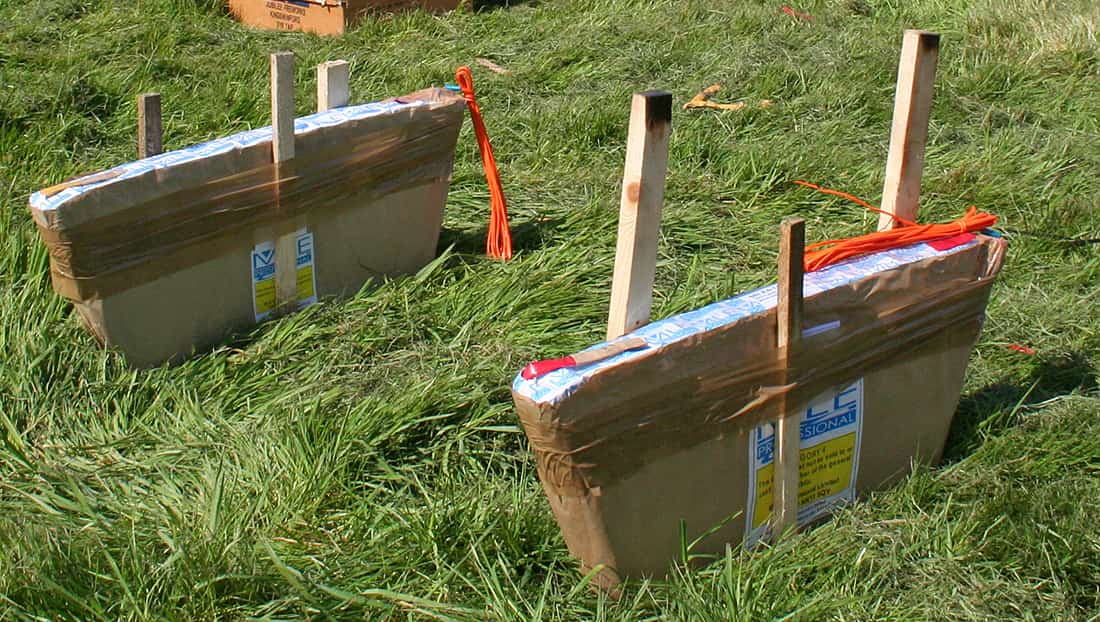
Very large and compound cakes
Many of the larger cakes and big compound fireworks are very, very heavy and once on the ground feel secure even without being staked. Whilst the chances of these tipping over is remote, I still recommend staking and taping. The main reason is that it helps to give the firework stability in case an effect explodes in a tube.
Setting up cakes on hard ground
Concrete or tarmac poses the obvious problem of having nowhere to bang a wooden stake into the ground. In this case you will need to find an alternative way to secure your cakes. The aim is to ensure they cannot fall over.
Each case is different in terms of what equipment you have available and your technical skills, but some examples to consider include:
Building wooden frames. Here you would build either a crate-like structure to place and secure your cakes in, or a wooden board with suitable attachment points.
Using sand bags. These can be placed against all four sides of the firework to ensure it can’t move.
Using bricks or slabs. An alternative to sand bags, but ensure they are heavy enough to keep the firework in place. Breeze blocks are better laying on their large side as this creates more friction.
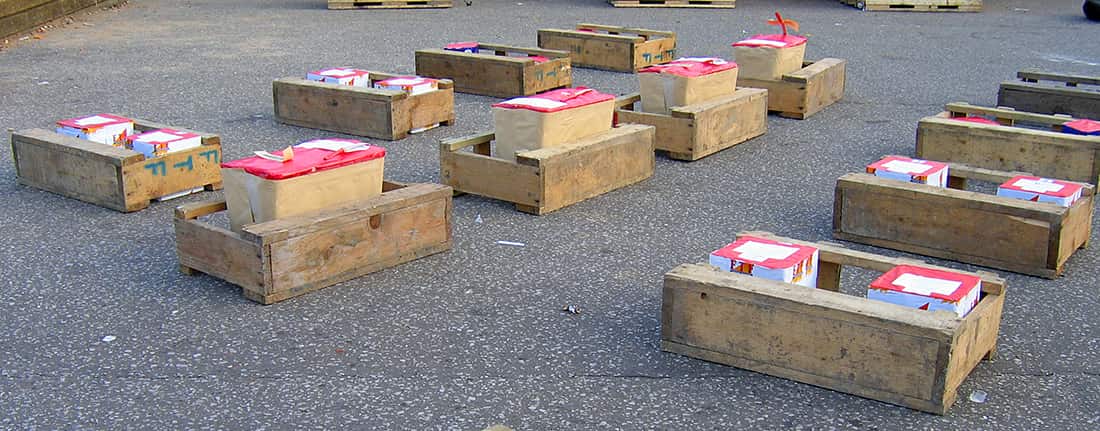
Securing cakes on sand or the beach
For obvious reasons you need to avoid any really wet areas and fully waterproofing at least the base and sides your fireworks is recommended unless you are firing them immediately after each one is secured. This is because on many beaches you don’t have to dig too deep to get to moisture and this can soak into your fireworks. An easy way to do this with cakes is simply to place them in a bin bag before staking. See the Coping With Bad Weather section for more help on this.
Only very large cakes with stable, wide bases (i.e. wider than they are tall, in all directions) should be bedded directly into sand or shingle, slightly angled if required. Everything else, ideally, should be staked to prevent recoil causing the cake to move and tip over.
You are likely to need longer stakes than for lawned areas because you might need to go quite deep to get the stake firmly bedded. Metal fence posts might be more suitable depending on the surface because they are easier to knock in.
Ensure the fuses are easily accessible and be careful not to bury any fuses on the sides of your fireworks.
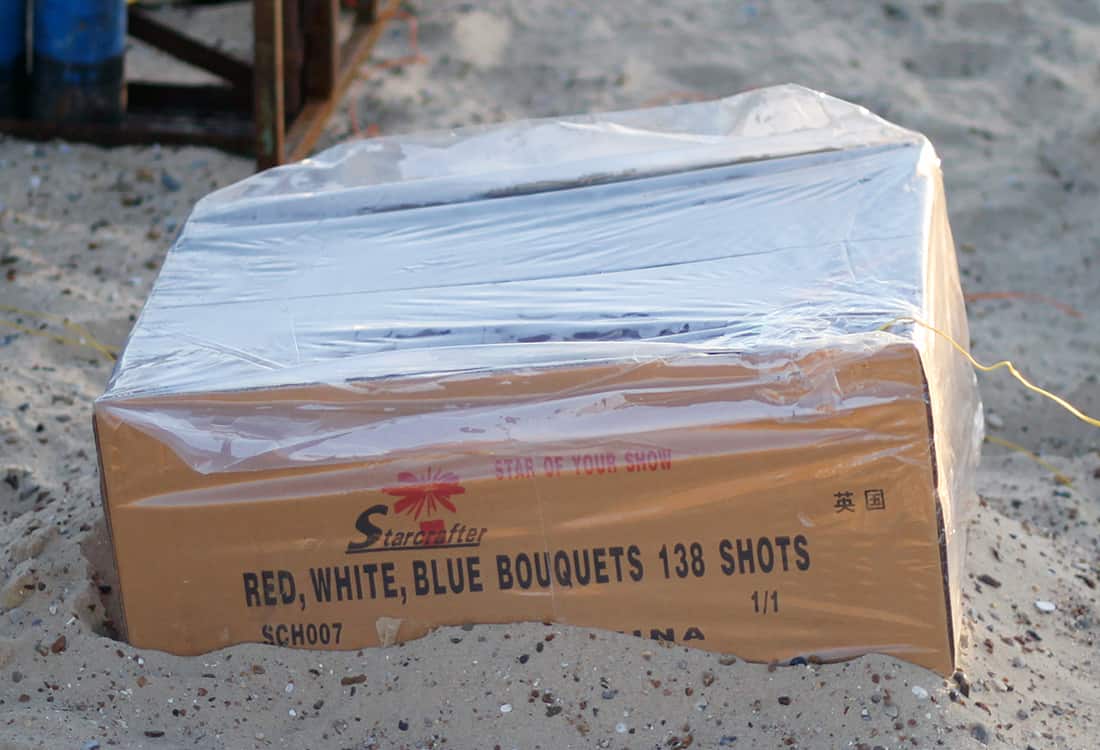
It goes without saying, I hope, that if you are setting up on a beach to fire later, do check the tide times! And please, clear up your firework carcases and any other pyro litter afterwards.
Cake packaging and cellophane tops
Unless instructed to do so on the label, you do not need to remove any of the packaging – which is typically red see-through cellophane or printed paper – from the top of your cakes. This will in fact blow off with the first few shots. In most cases it is purely there for decoration.
The reason some firers do remove this anyway is simply to reduce the amount of litter that is strewn over your firing site. The process of removing it is known in firework circles as “skimming”. However it is entirely a personal choice whether to do so, it does not affect the firework’s performance.
Be aware there are a small number of cakes with special packaging which does need to be removed first – but this should be clearly noted on the firework. This is typically for cakes with plastic missile style shots. The wrapping helps keep them in place during transit. With that in mind, don’t tip the firework upside down after removing it as the shots may fall out!
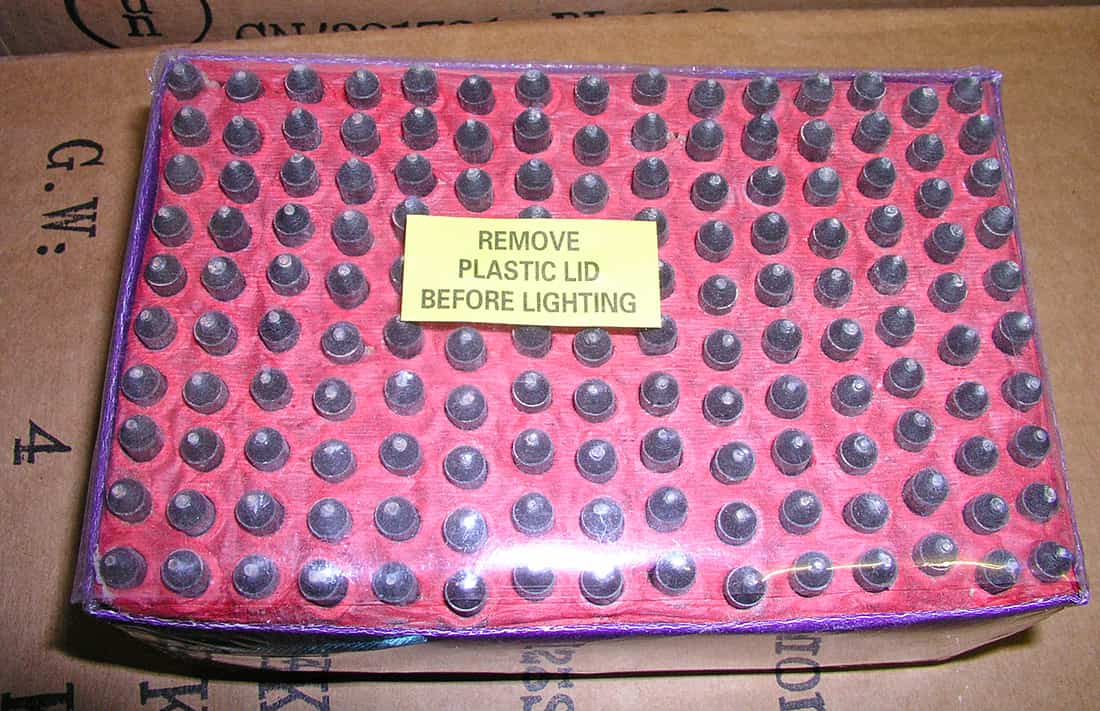
Angling cakes
In most cases if you want an angled effect from cakes you would of course buy a fanned cake which is designed to do this. However as you get more experienced you may want to fire straight-firing cakes at angles. A common example is firing multiple smaller cakes together at angles to create a V-shaped effect.
Angling cakes is perfectly safe to do so long as they are well secured and cannot tip over. In the simplest form you can simply use a wooden board as a base with a strip of wood screwed under one side to create an angle, and stake accordingly.
To be more creative or to ensure your angles are symmetrical then building a wooden base for your cakes is relatively straightforward to make and you can add angled sections as required.
Never angle a cake or any other firework towards your spectators.
Setting up candles
Exactly the same principles apply to candles as they do to cakes, so you can apply the stake and tape method here too:

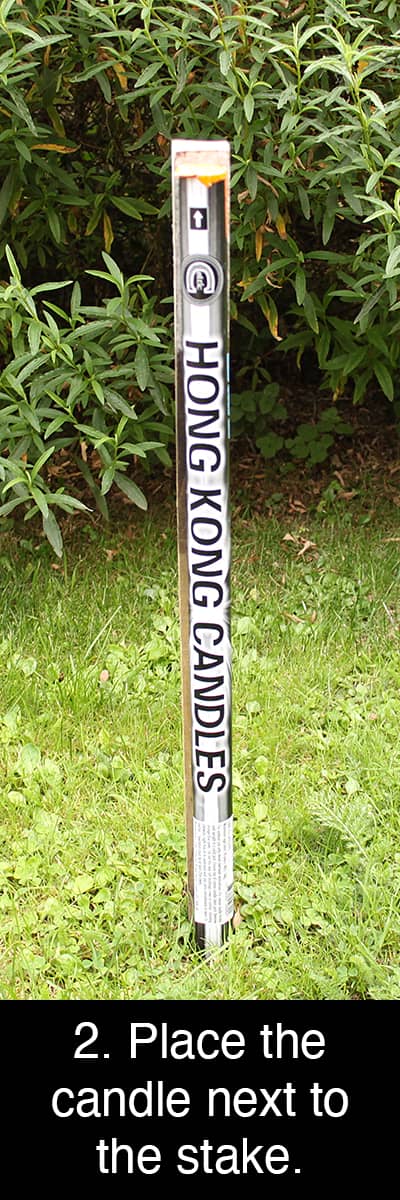

Always bang the stake in first then attach the candle to it. Don’t tape the candle to a stake and try and hammer it in as you could damage the firework.
The fuses on candles and candle bundles are nearly always on the top. However if they are on the side then as with cakes above, avoid taping over this part.
Although many firers like to use cable ties with candles – for speed and simplicity – you need to be careful not to over-tighten them as this could constrict the tubes and cause a misfire. There has also been some concern about whether the expansion of the tubes during firing can cause cable ties to snap, as they are not as stretchy as tape. This is why, in general, I recommend sticking with gaffa tape.
As with cakes, placing a wooden board under the candle will help secure the base and protect it from damp ground.
Angling candles
Candles can look wonderful when fanned and this is easy enough to do. Banging your stakes in at the required angle is all that’s needed in most cases to achieve this effect.

If you want something a little more perfect in terms of angles and also reusability, candle racks made from timber are easy enough to build. Essentially this would be three (for example) stakes angled as per the above photo but with horizontal wooden sections securing them in place. This whole rack can then simply be gaffa taped to a wooden stake to keep it in place.
Setting up candles on hard surfaces
This requires a bit more thought because candles absolutely cannot stand up on their own. There are many ways to do this from building wooden or metal frames to securing candles inside drinks crates and the likes. Really the best method is more dependent on the items you have available to build it; as long as the candle cannot fall over once secured then it should be fine. An example is shown below:
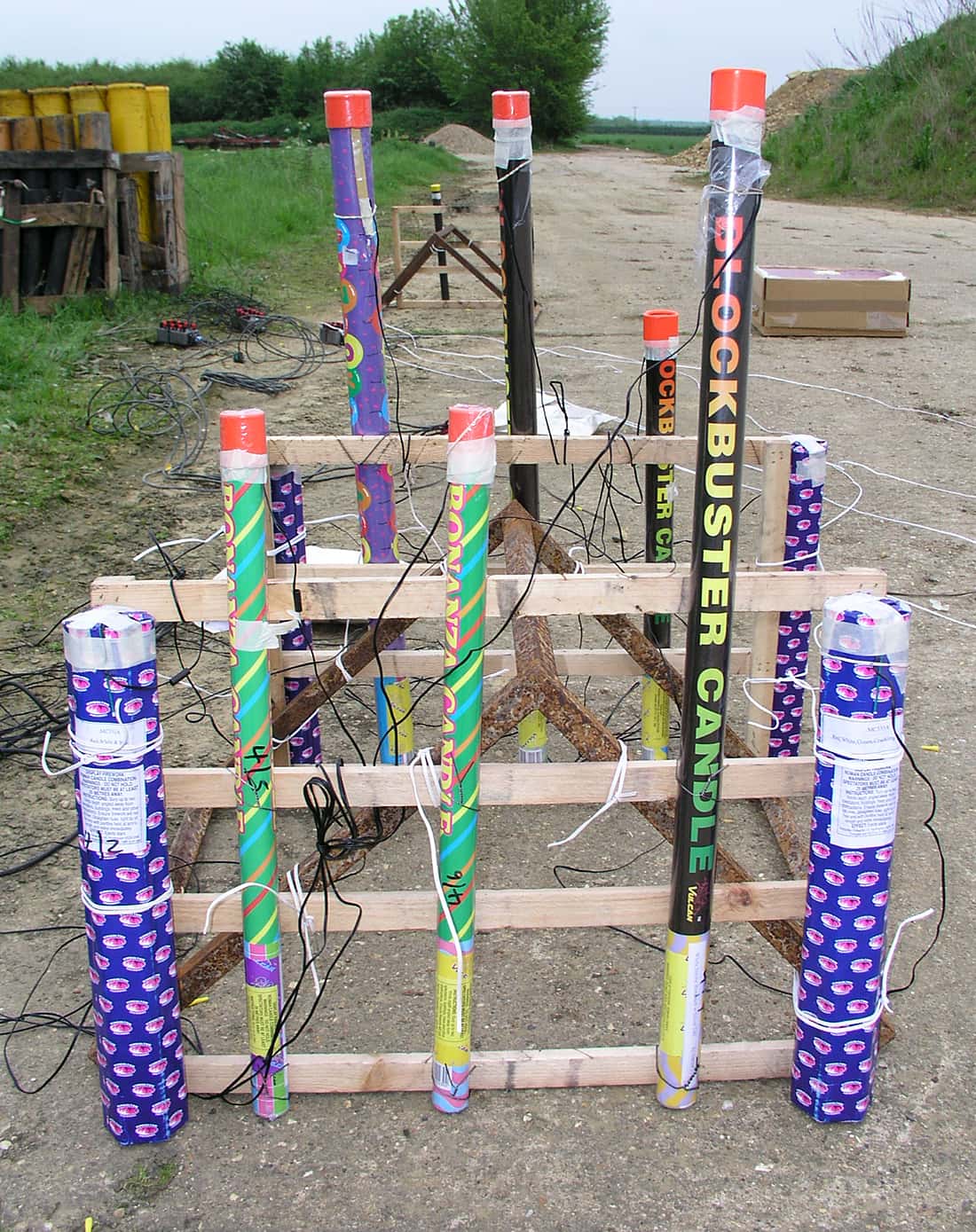
Setting up mines and dump cakes
Mines tend these days either to be cake-shaped (known as “dump cakes” as they fire all their shots at once) or the old school tube or cylinder design.
For cake-shaped mines, follow the advice for cakes above. For tubes and cylinders follow the advice for candles above.
Waterproofing your cakes, candles and mines
Making your fireworks weatherproof isn’t hard and if you are setting up in advance during the day it is recommended even if rain is not forecast. This is because in the UK it is always guaranteed to pour down on your fireworks if you decide not to waterproof them, even in the middle of summer and if the forecast was dry for the next three weeks.
Then there’s also the prospect of damp or dew which can quickly ruin any cake, candle or mine.
So you won’t be surprised to know that I have a complete section on this covering all types of fireworks: Coping With Bad Weather.
Further help and information
For help with setting up other fireworks such as rockets or fountains, head back to the Setting Up Fireworks menu section where you will also find site layout advice and other helpful articles.
Once you have set up and are ready to fire check out my section dedicated to letting off your fireworks safely.
If you are a beginner and any of the terms used in this guide are unfamiliar, or you are new to UKFR, my Beginners Start Here! guide will walk you through the basics.